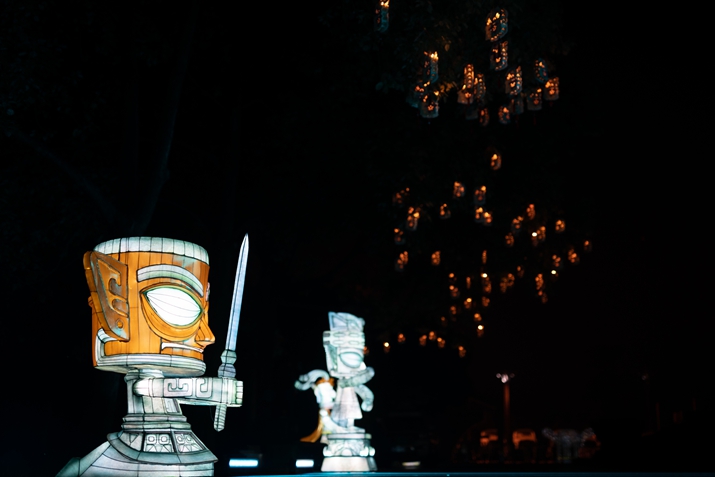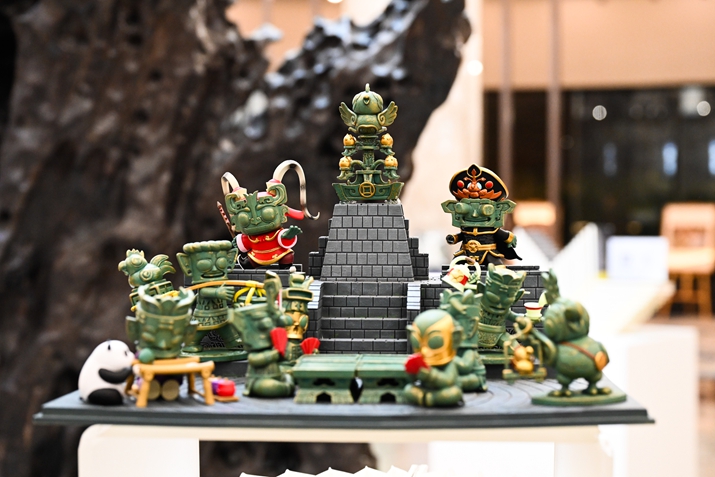| Lifestyle |
| Culturally themed products breathe new life into ancient artifacts | |
|
|
 A light show at the Sanxingdui Museum in Sichuan Province on May 28 (XINHUA)
On the night of June 15, the Sanxingdui Museum live-streamed a visit to the museum and many in the audience called for the museum to launch "blind boxes" that contain replica artifacts that need to be repaired. Unexpectedly, an official of the museum said such blind boxes are in the pipeline. That means when the product is launched, ordinary people can experience the pleasure of restoring artifacts for the museum. This is not the first time that the museum has garnered attention for its culturally themed products. On the morning of May 1 this year, the first day of the May Day holiday, over 1,200 newly launched ice cream bars in the shape of the iconic bronze mask from the site sold out in no time. There were two flavors for the popsicles: matcha and chocolate. The popularity of the site's culturally themed products can be partly attributed to the latest excavation of six sacrificial pits at the site in March. The excavation was broadcast live on TV and the Internet, attracting widespread public attention. The excavation has also greatly boosted tourism to the site. During the Qingming Festival holiday from April 3 to 5, 45,300 tickets were sold, worth 2.47 million yuan ($381,615), up 278 percent and 330 percent respectively against the same period in 2019. With the increase in tourist numbers, culturally themed products from the site have also gained popularity. New twist Some artifacts of the Sanxingdui site were discovered by chance by a local farmer in 1929, with thousands more unearthed in the 1980s. Artifacts included numerous bronze items and a golden mask, all of which provide valuable insights into the ancient Shu culture of the region. In 2001, more than 4,000 artifacts with a close connection to Sanxingdui were unearthed at the Jinsha Ruins site in downtown Chengdu, capital of Sichuan Province. The Sichuan Provincial Government announced in May that it will apply for UNESCO World Heritage status for the two sites. Since June 2019, the Sanxingdui Museum has developed over 300 themed products, including key rings, notebooks, clothes and mugs designed either by itself or in collaboration with other cultural companies. On May 18, the Sanxingdui Museum launched a set of blind boxes containing replica figurines of pigs, chickens, birds and a bronze tree unearthed from the site. The figurines were caked in earth similar to the earth in the sacrificial pits excavated in March. People have to remove the earth to see the figurines, similar to archaeological excavation. The museum has also organized product design competitions in recent years to attract organizations and individuals to maximize the commercial value of those ancient artifacts and popularize their cultural value. In May 2020, the museum opened an online shop for its culturally themed products on e-commerce platform Taobao with 48 products, including T-shirts, bookmarks and earrings. "Sales volume of culturally themed products from the Sanxingdui Museum in May alone is tantamount to the whole year's sales volume of the museum's culturally themed products last year," Ren Ren, Director of the Industry Development Department of the museum, told Chinanews.com. Wang Liping, a tourist from Nanjing in Jiangsu Province, bought bookmarks and key rings from the museum shop for her relatives and friends. She said that she wanted her relatives and friends who hadn't been to the site to learn about its history and culture through the products. The Sanxingdui product studio is one of the teams developing products for the museum. The studio has created over 30 products since 2016, including the popular ice cream bars. Feng Shixiong, Design Director of the studio, said that the studio selected some well-known bronzewares as inspiration for their creation. "The products are created by studying the characteristics of ancient artifacts and they serve to attract more people to develop an interest in the ancient Shu culture of the site," Feng said. The average age of the designers at the studio is 30, with some of them born after 1995. Feng said these young people are open-minded, fashionable and imaginative, all important qualities for designing cultural products. Young designers are also active in following the latest trends, or even setting them. For example, Chen Qilang, one of the designers born in 1999, said seeing Sanxingdui-related products having become so popular now gives her a great sense of achievement. She said the studio will launch blind boxes for ice creams to capitalize on the current craze for these boxes among young people in China to make the products more attractive.  Sanxingdui- themed products on display at the Sanxingdui Museum on May 28 (XINHUA)
A thriving industry The Sanxingdui Museum is not the only institution to have come up with such product lines. Take ice pops for instance. Many other institutions including the Palace Museum in Beijing and the Mogao Caves in Dunhuang, Gansu Province, have also launched similar versions. According to the survey of 60,000 enterprises in culture and related industries, in 2020, the enterprises achieved an operating revenue of 9.85 trillion yuan ($1.52 trillion), which was 2.2 percent higher than that of the previous year. Themed products produced by museums have become an important part of this particular industry. According to a report on the new products published jointly by the Institute for Cultural Economy of Tsinghua University and Alibaba in August 2019, the number of knickknacks produced by museums available on e-commerce platforms Taobao and Tmall increased threefold in 2019, compared to 2017. A guideline on copyright, trademark and brand authorization of museum resources published by the National Cultural Heritage Administration in 2019 lays out the specific procedures for museums to authorize the relevant intellectual property rights of their artifacts. In keeping with the guideline, museums are authorizing design companies or cartoon or game companies to use their intellectual properties to develop products. They are also collaborating with famous brands to create new products. For example, the Dunhuang Museum in Gansu has cooperated with famous Chinese sportswear brand Li Ning to produce Dunhuang-themed sportswear. However, the culturally themed industry still has a long way to go. Zhang Jingqi, a doctoral candidate in cultural policy at the Party School of the Central Committee of the Communist Party of China, said it still faces the problem of homogenization, and a mature and complete industrial chain is lacking. Unlike the British Museum whose creative products are welcomed in both domestic and foreign markets, China's products have yet to reach the global market, Zhang added. (Print Edition Title: Reviving Tradition) Copyedited by Ryan Perkins Comments to jijing@bjreview.com |
|
||||||||||||||||||||||||||||
|